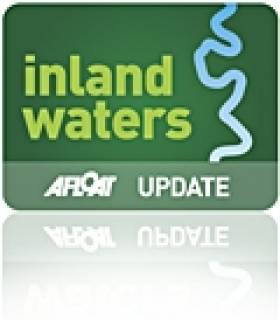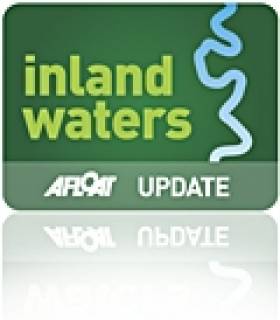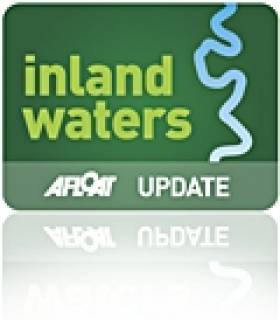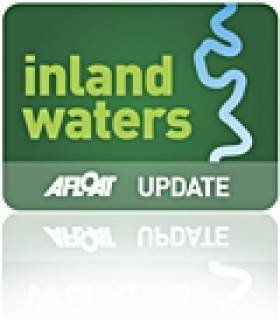Displaying items by tag: River Shannon
Canoe Challengers Promise 'Irish Deliverance' for Charity
#CANOEING - A team of hardy souls from Leamington Spa in England will attempt to paddle their way across the island of Ireland for charity from next weekend.
The Leamington Courier reports on the 13-strong 'Irish Deliverance' team, which will set out on five Canadian canoes from the Giant's Causeway on the Antrim coast next Friday 24 August.
They will be following a route through Lough Neagh and Lough Erne and across the border along the River Shannon all the way to Limerick, which they hope to reach by Sunday 2 September.
Team leader Jon Devaney says the group has been practising for months for the 372-mile challenge, aiming to raise money for the Warwickshire and Northamptonshire Air Ambulance.
And it's not the first time he's embarked on such an epic voyage - with Devaney, his brother David and friends completing the 10,000-mile Mongol Rally last year, and raising more than £7,000 (€8,900) for the air ambulance service in the process.
The Leamington Courier has more on the story HERE.
#INLAND WATERWAYS - The Lakelands & Inland Waterways Ireland Sailing Raid is a unique event combining sailing, adventure, exploration and racing in the setting of some of the most stunning countryside in Western Europe.
On 14-21 September a fleet of about 40 'open' boats – including the 5.5-metre Shannon One Design, the 4.5-metre Water Wags and various traditional styles and new builds all under 7.5 metres long – will sail 190km from Lough Erne in Northern Ireland, through the River Shannon and across the great lakes of Lough Ree and Lough Derg to Killaloe.
Although it will be a competitive race, there will be some time left to enjoy the scenery and the Irish hospitality of the three participating yacht clubs along the way. Some will come for the racing, some for the scenery, some for the spirit of comraderie – but everyone is sure to enjoy the craic.
To maintain the maritime nature of the event, the Lakelands & Inland Waterways Ireland Sailing Raid will be based as much as possible on the water.
Accommodation will be provided in motor cruisers for those who want it, while some will be able to camp near the river bank and others will make their own arrangements. Each stopover will therefore bring together participants in a 'floating village', with several receptions and festivities in the evenings.
The event is being organised in close collaboration with Waterways Ireland, with logistical support will be provided by the three main yacht clubs on the route: Lough Erne Yacht Club, Lough Ree Yacht Club and Lough Derg Yacht Club.
Members of the local clubs are being invited to take part at a preferential rate, while raid competitors from all over Europe will provide an international element to the event.
For more information and application details, visit the Sailing Raid website at www.sailing-raids.com.
Two Waterside Country Homes From Very Different Eras
#WATERFRONT PROPERTY - Two exclusive waterside homes, representing two distinct eras in Irish property, have come to the market in recent weeks, both with an asking price of €800,000.
Lakeside House in Barrymore, Co Roscommon is a spacious detatched house on the shores of Lough Ree in an exclusive residential area just minutes from the amenities of Athlone.
Built in 2002 by the current owners and set on a mature wooded site with an overall floor area of 385 square metres, accommodation comprises an entrance hall, a drawing room with marble fureplace, a living room with french doors to the deck, a sun room with domed ceiling, a fully fitted kitchen/breakfast room with marble style worktops and a utility room, plus a games room and bar.
The first floor features five bedrooms including a master bedroom, all en suite, with a separate bathroom with Jacuzzi bath. A sixth en suite bedroom is located on the ground floor.
Outside, tiled patios surround the house on three sides, with a large deck area featuring a hot tub, picnic table and seating. The gardens extend to the water's edge with a private pier and landing stage with access to fishing and sailing on Lough Ree and the River Shannon.
Lakeside House is for sale by private treaty through Finnegan Menton. See more details on this property HERE.
Meanwhile, in Co Clare, Abbey House is a charming family home built in 1770 to a design by the famed architect James Gandon.
Set on more than three acres of gardens next to St Flannan's Cathedral in Killaloe, Abbey House is typical of the Georgian era, comprising three reception rooms, a large country kitcten, five/six bedroom (two en suite), a large bathroom, plus a cloakroom and laundry room.
The house was restored in the 1980s but many of its period featured were retained, such as the 18th-century Wyatt windows to the front, and the original joinery throughout.
Outside is a large courtyard with outbuildings, leading to the stone walled garden and orchard surrounding the house that provides considerable privacy, not to mention the canal bank (leased from Waterways Ireland) that runs parallel to the River Shannon.
Abbey House is for sale by private treaty through joint agents Knight Frank and Harry Brann. See more details on this property HERE.
Trial Dredging to Help Rid Barrow of Invasive Asian Clam
#INLAND WATERWAYS - Trial dredging operations to curtail the spread of Asian clams at designated sites in the lower River Barrow are set to conclude today.
Inland Fisheries Ireland (IFI) employed the use of a a traditional cockle harvesting boat to physically remove the clams from the river bed, in an effort to explore methods of controlling or eradicating what it describes as an "ecosystem-changing invader" in other infested waters.
IFI scientists supervised the trials, using teams of divers to quantify the result of the dredging efforts.
The Asian clam (Corbicula fluminea) is "a most unwelcome addition to the fauna of the lower River Barrow". The bivalve mollusc is regarded as "one of the most notorious aquatic invasive species in the world".
First recorded in the river downstream of St Mullin’s in April 2010, subsequent IFI studies have revealed that the Asian clam is firmly established in the lower Barrow and in the River Nore downstream of Inistioge. Populations have also been recorded in the River Shannon and in Lough Derg.
In one section of the River Barrow the clam has achieved a "staggering" density of almost 10,000 per square metre.
Dr Joe Caffrey, senior scientist with IFI, said of the trial dregding: “It is imperative that every effort is made to control the expansion and spread of this highly adept invasive species.
"The results from these trials will inform future national management plans for this most unwelcome non-native species and will, at the very least, dramatically reduce the numbers of individuals in the test sites.
He added: "In tandem with these trials, research effort is being focused at producing other control methods that can be targeted as this species.”
Father-Son Duo in Charity Paddle from Dublin to Donegal
#KAYAKING - A father-and-son duo from north Co Dublin will shortly embark on an epic kayak paddle from Dublin to Donegal, the Fingal Independent reports.
Dermot Higgins and his son Fionn, from Rush, will attempt to kayak from Dublin Port to the Atlantic Ocean at Ballyshannon - a distance of some 330km - by way of the Royal Canal, the River Shannon and Lough Erne.
The Higgins' - who believe they are the first to attempt such a feat - will be completely self-sufficuent for the duration of the challenge, which is hoped to raised funds for the Rush Open Organisation for Transition Status (ROOTS), a charity that intends to help communities reduce their carbon footprint and face up to environmental challenges by encouraging sustainability.
The Fingal Independent has more on the story HERE.
Amateur Photo Contest Celebrates Shannon's Biodiversity
#LIFE ON THE SHANNON - MulkearLIFE has launched its amateur photo competition for 2012, with a prize fund of €1,000 on offer.
The contest celebrates the 20th anniversary of the EU LIFE programme and has the theme of ‘Exploring the Biodiversity of the Lower Shannon’. Images may cover any aspect of the theme, and can be submitted in any style from macro to landscape, black and white or colour.
There is no end to what type of image can be submitted. It could be an image of water, trees, plants, fish, invertebrates, fungi, mammals, birds, lichen, domestic animals - basically any living organism.
Though not essential, images that portray biodiversity in and along rivers, streams and waterways throughout the Lower Shannon region would be preferred.
Entry is free, and entrants can submit up to three images. Prizes will be offered in two categories: Children/Young Adults and Adults.
In addition, the overall winner will receive one full day's training in wildlife and landscape photography from a leading wildlife photographer later in 2012.
Full details of how to enter the competition are available on the MulkearLIFE website HERE. The closing date is 1 May 2012 at 5pm.
Bidding Begins for Shannon Harbour Houseboat Berths
#SHANNON - Waterways Ireland has just released details of its scheme for renting berths for houseboats on the Grand Canal at Shannon Harbour.
Under the scheme, boaters can rent one of eight fully-serviced berths for their houseboat on a 12-month extended term licence running from 15 March 2012 to 14 March 2013.
Amenities on-site include electricity supply, access to pumps and clean water, shower facilities and limited car parking. Pre-paid smart cards are required to utilise some facilities.
As space is limited, the berths will go to the highest bidders, with the minimum acceptable bid set at €1,250 (a security deposit of €250 is required).
It is expected that licence holders will live on board their vessels as their main residence. Winning bidders are also expected to arrange their own refuse collection from the site.
The closing date for bids is 23 February 2012. The Waterways Ireland website has the application form plus more information about the scheme and details of the licence agreement.
Shannon Sluice Gates Opened to Allay Flood Concerns
#INLAND WATERWAYS - Sluice gates have been opened at locks and dams along the River Shannon due to flooding concerns, The Irish Times reports.
The ESB confirmed that water levels in the upper Shannon had been rising significantly since September, and were just below those recorded prior to the flooding in Carrick-on-Shannon two years ago.
However the flooding threat has abated this week, with levels in Lough Allen dropping by around 300cm, although the situation is still subject to amounts of rainfall in the coming days as the Shannon drains slowly.
Levels in Lough Ree have also stabilised after rising throughout October.
The ESB continues to discharge from the Ardnacrusha power plant, while Waterways Ireland has commenced dredging at Meelick in Co Galway.
The Irish Times has more on the story HERE.
A Perfect Getaway on the Shannon in Co Cavan
With an asking price of just €149,000, the high quality log cabins at River Valley in Ballyconnell, Co Cavan could make the perfect getaway for river boating enthusiasts.
Nestled in a scenic forest area just two hours from Dublin on the banks of the Shannon-Erne waterway with a private marina on-site, these waterfront properties are ideally suited for use as a family home or an upmarket holiday retreat.
Located only four miles from the town of Ballyconnell and eight miles from Ballinamore, the unique gated development offers privacy for any buyer, with each property sited on approx 0.22 acres of grounds surrounded by trees.
With an option to purchase/lease a berthing space, these spacious homes (circa 150 sqm) comprise a porch, fitted kitchen with appliances, dining area, sitting room, balcony and living area, bathroom and three bedrooms (one ensuite).
Other features include a private gated entrance, spacious secluded sites, and a private marina.
Viewing at River Valley is strictly by appointment only with Gordon Hughes Estate Agents at 071 964 5555 or www.ghproperty.com.
More details about the properties at River Valley are available HERE.
Waterways Returns to the Screen This Sunday
Waterways returns to RTÉ television after 16 years off the air this coming Sunday.
The original award-winning 1990s documentary series saw naturalist and poet Dick Warner undertake an epic journey traversing the canals of Ireland by barge.
This year filmmaker Stephen Rooke accompanied Warner as he returned to our inland waterways, this time to explore the newly restored Royal Canal and celebrate the reopening of the entire route from Dublin to the Shannon.
As previously reported on Afloat.ie, Warner travels on the Rambler, an original canal tug barge, from Dublin to Lough Ree - the first time it had followed the route since 1923.
Along the way, Warner meets both experts and ordinary people who live along the banks, learning from them about its heritage, history and wildlife.
Filming is now complete on the new six-part series, Waterways - A Royal Canal, which begins this Sunday night.
According to Irish Film and Television News, Rooke re-assembled the core team from the original series, many of whom have gone on to work on successful films and TV shows.
The series begins on RTÉ One at 8.30pm on Sunday 2 October.






































































